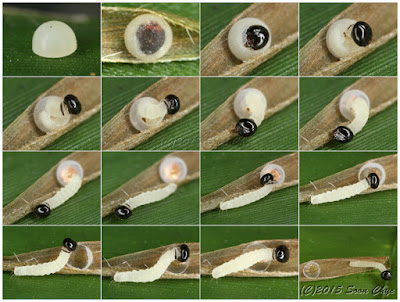Butterfly description:
The species is moderately common in Singapore and not rare in Peninsula Malaysia, it can be found at all usual elevations, in both primary and secondary forest. Range from India to China and Sundaland. The adult have been observed to visit flowers and sunbathing.
Further reading: Identification of Potanthus trachala
Host plant description:
Imperata cylindrica, Lalang (Singapore)
Ischaemum barbatum (HK)
Neyraudia reynaudiana (HK)
Panicum maximum (HK)
Early stage description:
The eggs of Potanthus trachala are laid singly on the underside of the grass blade of the host plant. The dome-shaped egg is creamy white.The early stage of the Potanthus trachala complete in 6th instar.
| Egg of P. trachala (day 1). |
 |
Maturing egg of P. trachala with head capsule visible through the
egg shell (day 3)
|
It takes 3 - 4 days for the egg to hatch. After emergence, the caterpillar will devour the rest of the egg shell. The newly emerged caterpillar is creamy white with black head capsule, and a black line right behind the capsule on the prothorax. There're also numerous long and tiny hair (setae) at the posterior end of the body.
 |
| Caterpillar of P. trachala hatching sequence (day 4). |
The body color of the 1st instar larva turns to greenish after a few feeding sessions on the grass blade. The instar lasts about 5 days.
 |
| 1st instar larva of P. trachala |
 |
| 1st instar larva of P. trachala, moulting to 2nd instar |
 | |
|
 |
| 3rd instar larva of P. trachala |
The 4th instar larva has yellowish-green coloration on body. The instar takes about 6 - 8 days to complete.
 |
| 4th instar larva of P. trachala |
 |
| Internal structure of the leaf shelter of 5th instar larva |
 |
| 2 views of the 5th instar larva of P. trachala |
 |
| 5th instar larva of P. trachala, moulting to 6th instar |
 |
| 2 views of the 6th instar larva of P. trachala |
 |
| Head capsule view of 5th and 6th instar larva |
 |
| Anal plate of 6th instar larva |
 |
| 2 views of the leaf shelter |
 |
| Partial view of pupa after opening the leaf shelter |
 |
| Two views of the pupa |
 |
| Front-view of the pupa |
 |
| Tail-part of the pupa |
 |
| 3 views of semi pupa of Potanthus trachala (2 days before eclosion) |
1 day before eclosion, the head and thorax of pupa become darken and semi transparent. Upper-side wings marking briefly visible.
 |
| 2 views of mature pupa (1 day before eclosion) |
 |
| A newly emerged female Potanthus trachala |
Note: 3 eggs collected from the same female, hatched into 2 female and 1 male. Each larva mature at different speed and reached pupation stage 4 days apart. 1 female pupated on days 41, 1 male pupated on days 44, the last female pupated on days 45. From egg to adult took 51 - 53 days.
All larvae are kept in similar condition (room temperature and humidity).
REFERENCE:
* A Photographic Monograph on Hong Kong Butterflies (vol 4). HKLS.
* M. J. Bascombe, G. Johnston & F. S. Bascombe, 1999. The Butterflies of Hong Kong.
* Corbet, A. S. & H. M. Pendlebury, 1992. The Butterflies of the Malay Peninsula. 4th Edition (Revised by J. N. Eliot).


No comments:
Post a Comment